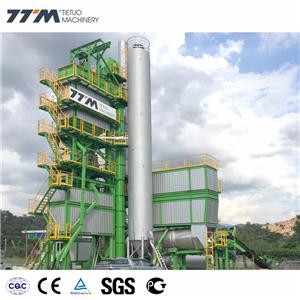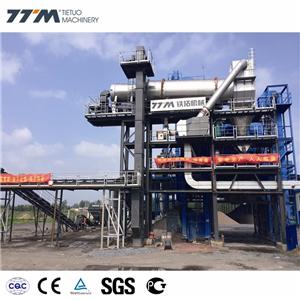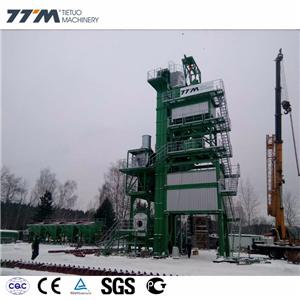شراء معدات رصف مصانع الأسفلت الساخن المعاد تدويره بأسعار رخيصة
مصانع الأسفلت الساخن المعاد تدويره معدات الرصف
شراء معدات رصف الأسفلت المعاد تدويره
تعمل وزارة النقل في ولاية مينيسوتا مع وكالات في ولايات أخرى لإجراء دراسة تمويل مركزية لتحسين أساليب اختبار مقاومة الشقوق في مخاليط الأسفلت. ولتوسيع الخيارات بشكل أكبر، تطلب وزارة النقل في مينيسوتا من الباحثين تقييم الاختبارات البديلة باستخدام معدات المختبر القياسية. وأعطت الاختبارات الجديدة نتائج قابلة للتكرار. تتضمن الأساليب اختبار الانحناء نصف الدائري (إس سي بي) للهيكل غير النمطي، واختبار معامل المرونة الديناميكي لعينة صغيرة من خليط الأسفلت، واختبار مقياس شعاع الانحناء (بي بي آر) للخليط واختبار بي بي آر لمادة الأسفلت لاختيار المادة الرابطة.
هناك العديد من العوامل التي تؤدي إلى تشقق الأسفلت والأضرار الأخرى. ستؤدي درجات الحرارة المنخفضة إلى انكماش الرصيف، مما يسبب توترًا داخليًا، مما يؤدي إلى حدوث تشققات بسبب درجات الحرارة المنخفضة. تصبح روابط الأسفلت القديمة هشة وتنتج تشققات من الأسفل إلى الأعلى أو تشققات التعب تحت ضغط التحميل. هناك العديد من الأسباب التي تؤدي إلى التشقق من الأعلى إلى الأسفل، مثل أداء الخليط، وتكنولوجيا البناء، وتصميم الإطارات والتحميل.
كان عمال بناء الطرق يعملون في الليل، ويضعون طبقة من الأسفلت.
عملت وزارة النقل في مينيسوتا مع (المركز الوطني لتكنولوجيا الأسفلت، والمركز الوطني لتكنولوجيا الأسفلت، ووكالات النقل في أربع ولايات أخرى للمشاركة في دراسة تمويل مركزية لتطوير اختبارات أداء الخليط للشقوق. في صيف عام 2016، قام الفريق، المسمى مجموعة الكراك، بتثبيت ثماني وحدات طرق مختلفة في من رود لاختبار أداء الرصف واختبار طرق درجات الحرارة المنخفضة والتشقق من أعلى إلى أسفل والتشقق الناتج عن التعب.
لا يتضمن نهج الفريق جميع الاختبارات الممكنة، بما في ذلك تلك التي توصلت إليها مؤسسات أخرى ومؤسسات بحثية والتي لها قيمة محتملة في التنبؤ بسلوك التشقق في مواد رصف الأسفلت.
تحاول وزارة النقل في مينيسوتا دراسة جدوى طرق الاختبار التي لم يتم تضمينها في دراسة مجموعة التكسير. سيتم إجراء هذه الاختبارات على مخاليط الأسفلت التي تم أخذ عينات منها أثناء إنشاء قسم اختبار من رود للمساعدة في اختيار المواد ومراقبة الجودة والتحقيقات الجنائية لمواد الرصف.
في جميع أنحاء البلاد، أصبحت الأرصفة القابلة للنفاذ أكثر شعبية من حلول الأرصفة التقليدية مثل الخرسانة والإسفلت غير القابل للنفاذ.
مصنع خلط الأسفلت المعاد تدويره
مصانع الأسفلت المعاد تدويره
يتكون الرصف المنفذ من شبكات متشابكة موضوعة على السطح الجاهز تحت الأرض. يتم ملء الشبكة بأحد مواد الحشو العديدة، مثل الحصى، أو الحجر الجيري المكسور، أو العشب. ويؤدي هذا إلى الحصول على سطح قوي ومتين ويحتاج إلى صيانة منخفضة.
ومن المتوقع أن ينمو سوق الرصف النفاذ العالمي من 2.13 مليار دولار في عام 2015 إلى 22.17 مليار دولار في عام 2026، بمعدل نمو سنوي مركب قدره 5.7 في المائة. يمكن أن يعزى نمو السوق إلى ازدهار صناعة البناء والطلب المتزايد على الحلول المتعلقة بإدارة مياه الأمطار.
بالإضافة إلى الفوائد البيئية، يمكن للرصف المسامي أيضًا أن يساعد مديري المشاريع على تقليل المواد والعمالة والمعدات والصيانة وتكاليف التشغيل على المدى الطويل.ومع ذلك، قد يكون لدى علماء البستنة تساؤلات حول مدى فائدة حلول الرصف النفاذة.
رأى ريان سميث شاحنة تتخلص من أطنان من الأسفلت القديم على تلة مقابل مطار جون جلين كولومبوس الدولي.
قبل بضع سنوات، كانت عبارة عن مساحة مفتوحة، واحدة من المساحات المفتوحة القليلة في نوع مشروع بناء الطرق الذي تصوره سميث.
اليوم، أصبحت موطنا لـ راب، مع أكثر من 200 شاحنة تقوم بتفريغ كميات كبيرة من مواد الطرق القديمة وسحب الخلطات الساخنة الجديدة إلى مواقف السيارات والشوارع. هذه منشأة مخصصة لإعادة رصف المزيد من الأسفلت القديم على الطرق الجديدة.
معدات رصف الأسفلت المعاد تدويره
معدات خلط ساخنة معاد تدويرها رخيصة الثمن
وقال سميث (سميث)، مؤسس ورئيس مجلس إدارة شركة راب: "من غير المستدام أن نستمر في استخراج المحاجر لإنتاج الأسفلت وتخزين المواد من الطرق التي نعيد بناءها".
وافق مجلس مقاطعة فرانكلين مؤخرًا على منحة قدرها 200000 دولار من سميث لتمويل نظام مناولة مادة الأسفلت المعاد تدويرها. يتقدم مكتب التنمية الاقتصادية بالمحافظة بطلب التمويل نيابة عن إدارة برنامج العمل الإقليمي.
ومنذ عام 2015، وبفضل تمويل مماثل من وكالة حماية البيئة في ولاية أوهايو، أكملت المقاطعة ستة مشاريع، وفقًا لجوش روس، منسق المشاريع الأول لمكتب التنمية الاقتصادية والتخطيط في المقاطعة. القيمة الإجمالية تزيد عن مليون دولار.
تجري مدينة نيو بلايموث تجربة على طريقة ثورية جديدة لإعادة تدوير البلاستيك الموجود على جانب الطريق بما يعادل 83300 علبة زبادي على جزء من الأسفلت في نيو بلايموث.
قام مجلس منطقة نيو بلايموث بتجديد 1455 مترًا مربعًا من شارع ليارديت، بالقرب من حديقة بوكيكورا، كجزء من تجربة لإعادة تدوير أنواع معينة من البلاستيك.
على الرغم من أن مساحة 200 متر مربع من منطقة وقوف السيارات عبارة عن أسفلت عادي، فإن الباقي عبارة عن أسفلت مخلوط بالبلاستيك يحتوي على علامات بلاستيكية معاد تدويرها 3-7، مثل زجاجات الشامبو.
باستخدام هذه العمليات، يتم طحن الرصيف الحالي، ثم يتم خلطه مع عامل التجديد، وإعادة رصفه وضغطه. يمكن ترتيب المعدات العاملة بالترتيب، لذلك هناك مصطلح "تدريب إعادة التدوير"h أو "eتدريب المعدات".




